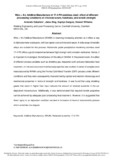JavaScript is disabled for your browser. Some features of this site may not work without it.
| dc.contributor.author | Caballero, Armando | |
| dc.contributor.author | Ding, Jialuo | |
| dc.contributor.author | Gaguly, Supriyo | |
| dc.contributor.author | Williams, Stewart W. | |
| dc.date.accessioned | 2019-09-02T13:51:09Z | |
| dc.date.available | 2019-09-02T13:51:09Z | |
| dc.date.issued | 2019-01-07 | |
| dc.identifier.citation | Caballero A, Ding J, Ganguly S. (2019) Williams S. Wire + Arc Additive Manufacture of 17-4 PH stainless steel: Effect of different processing conditions on microstructure, hardness, and tensile strength. Journal of Materials Processing Technology, Volume 268, June 2019, pp. 54-62 | en_UK |
| dc.identifier.issn | 0924-0136 | |
| dc.identifier.uri | https://doi.org/10.1016/j.jmatprotec.2019.01.007 | |
| dc.identifier.uri | https://dspace.lib.cranfield.ac.uk/handle/1826/14501 | |
| dc.description.abstract | Wire + Arc Additive Manufacture (WAAM) is receiving increasing attention as it offers a way to fabricate meter scale parts, with relatively low capital cost, lower material wastage and logistical advantages. A wide range of metallic alloys could be manufactured using this process. Martensitic grade precipitation-hardening stainless steel 17-4 PH offers excellent combination of high strength and corrosion resistance. Hence, it is important to investigate the behaviour of this alloy in WAAM. In the present work, the effect of different process variables such as shielding gas, deposition path and post-fabrication heat treatment, on microstructure and mechanical properties were studied. A number of specimens were manufactured by WAAM using the Fronius Cold Metal Transfer (CMT) process under different controlled processing conditions. These specimens were subsequently characterized by optical and electron microscopy and mechanical properties in terms of tensile strength and hardness. It was found that using shielding gases that result in higher heat input reduces the amount of retained austenite in the as-deposited microstructure. It has been demonstrated that the required tensile properties can be achieved by applying post-deposition heat treatment. However, it is suggested that direct aging in as deposited condition resulted in formation of harmful intermetallic phases which embrittles the deposit. | en_UK |
| dc.language.iso | en | en_UK |
| dc.publisher | Elsevier | en_UK |
| dc.rights | Attribution-NonCommercial-NoDerivatives 4.0 International | * |
| dc.rights.uri | http://creativecommons.org/licenses/by-nc-nd/4.0/ | * |
| dc.subject | Additive manufacture | en_UK |
| dc.subject | WAAM | en_UK |
| dc.subject | Retained austenite | en_UK |
| dc.subject | Stainless steel | en_UK |
| dc.subject | 17-4 PH | en_UK |
| dc.title | Wire + Arc Additive Manufacture of 17-4 PH stainless steel: Effect of different processing conditions on microstructure, hardness, and tensile strength | en_UK |
| dc.type | Article | en_UK |
Files in this item
The following license files are associated with this item:
This item appears in the following Collection(s)
-
Staff publications (SATM) [4367]

